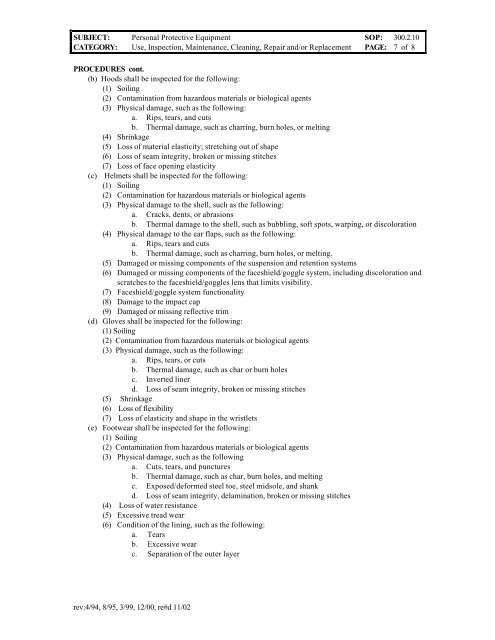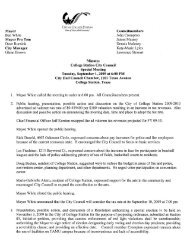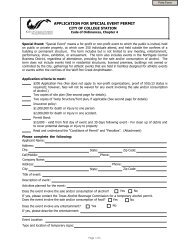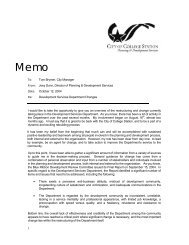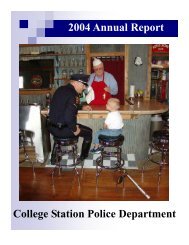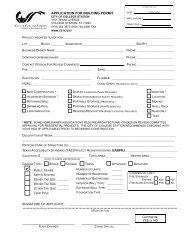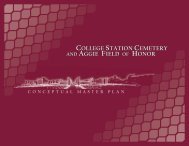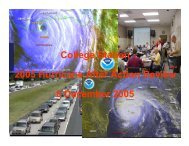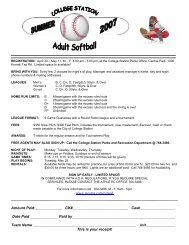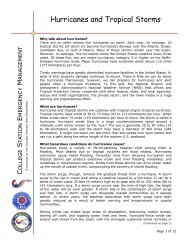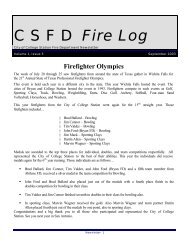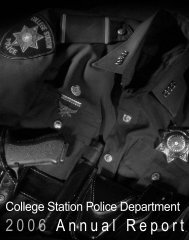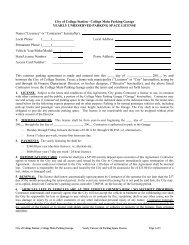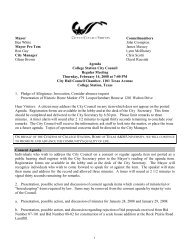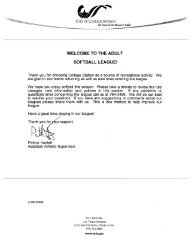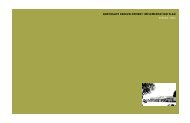standard operating procedure college station fire department
standard operating procedure college station fire department
standard operating procedure college station fire department
Create successful ePaper yourself
Turn your PDF publications into a flip-book with our unique Google optimized e-Paper software.
SUBJECT: Personal Protective Equipment SOP: 300.2.10<br />
CATEGORY: Use, Inspection, Maintenance, Cleaning, Repair and/or Replacement PAGE: 7 of 8<br />
PROCEDURES cont.<br />
(b) Hoods shall be inspected for the following:<br />
(1) Soiling<br />
(2) Contamination from hazardous materials or biological agents<br />
(3) Physical damage, such as the following:<br />
a. Rips, tears, and cuts<br />
b. Thermal damage, such as charring, burn holes, or melting<br />
(4) Shrinkage<br />
(5) Loss of material elasticity; stretching out of shape<br />
(6) Loss of seam integrity, broken or missing stitches<br />
(7) Loss of face opening elasticity<br />
(c) Helmets shall be inspected for the following:<br />
(1) Soiling<br />
(2) Contamination for hazardous materials or biological agents<br />
(3) Physical damage to the shell, such as the following:<br />
a. Cracks, dents, or abrasions<br />
b. Thermal damage to the shell, such as bubbling, soft spots, warping, or discoloration<br />
(4) Physical damage to the ear flaps, such as the following:<br />
a. Rips, tears and cuts<br />
b. Thermal damage, such as charring, burn holes, or melting.<br />
(5) Damaged or missing components of the suspension and retention systems<br />
(6) Damaged or missing components of the faceshield/goggle system, including discoloration and<br />
scratches to the faceshield/goggles lens that limits visibility.<br />
(7) Faceshield/goggle system functionality<br />
(8) Damage to the impact cap<br />
(9) Damaged or missing reflective trim<br />
(d) Gloves shall be inspected for the following:<br />
(1) Soiling<br />
(2) Contamination from hazardous materials or biological agents<br />
(3) Physical damage, such as the following:<br />
a. Rips, tears, or cuts<br />
b. Thermal damage, such as char or burn holes<br />
c. Inverted liner<br />
d. Loss of seam integrity, broken or missing stitches<br />
(5) Shrinkage<br />
(6) Loss of flexibility<br />
(7) Loss of elasticity and shape in the wristlets<br />
(e) Footwear shall be inspected for the following:<br />
(1) Soiling<br />
(2) Contamination from hazardous materials or biological agents<br />
(3) Physical damage, such as the following<br />
a. Cuts, tears, and punctures<br />
b. Thermal damage, such as char, burn holes, and melting<br />
c. Exposed/deformed steel toe, steel midsole, and shank<br />
d. Loss of seam integrity, delamination, broken or missing stitches<br />
(4) Loss of water resistance<br />
(5) Excessive tread wear<br />
(6) Condition of the lining, such as the following:<br />
a. Tears<br />
b. Excessive wear<br />
c. Separation of the outer layer<br />
rev:4/94, 8/95, 3/99, 12/00, re#d 11/02


